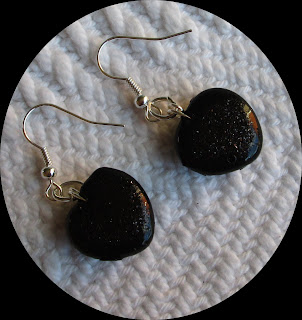I have a Facebook friend, Michele, who shares my jewellery making passion and loves experimenting with alternative media.
Together we have been working with jewel enamel UTEE and trying to push the boundaries of our skill and experience.
Last week Michele began to add craft glitter to her pieces with amazing results.
Craft glitter is not the classroom stuff of Christmas cards - it is very fine, made from a lightweight iridescent polymer that often changes colour with heat. This makes is easy to use with jewel enamel but as you will know if you have used UTEE the temperature is very hot ( 140C) which can distort the particles causing them to clump.
Following Michele's experimenting I had to try some myself so armed with mini taster pots of lovely colours I spent a Saturday morning experimenting.
As Valentine's day is looming I thought I would try a red puffy heart with red glitter added to the pan - disaster - it was obviously too hot and just formed a gunge clump!
Next I decided to use a white powder that already has glitter in it so added a swirl - disaster - the white was so opaque that it over powered the red and made a sickly pink with very little glitter showing.
Romance be blowed! By the way nothing is wasted - all scrap can be recycled!
I cleaned out the pot and chose blue - deciding to add a small sprinkle of glitter to the mould rather than the pot. This time success!
this lovely puffy heart has two colours of glitter-a blue and iridescent white
I have added a brooch pin to the back deciding to leave the simplicity of the heart
Next I went for spring colours and chose a light turquoise with peridot green, lightly swirling the two together so that they didn't mix but marbled. Again I added the glitter to the mould
this face mould reminds me of the Easter island statues
the puffy heart with green glitter added to one side
I still had some melted enamel in the pot so used a silver bezel to pour into
this time as I heat polished the surface I added a small amount of green glitter to the soft enamel
To finish my session I used a new colour Apatite Green which is probably more sludge green with dark gold undertones. So I decided to make a heart charm bracelet with gold findings.
I wanted to grade the colour from green to gold so after pouring two hearts I added a small amount of clear and let it begin to turn amber then poured again. The next pour I added a little gold which really began to alter the colour and then for the final pour it was almost all gold.
At the mid point of the colour transition I dipped a pair of earrings and with the final colour I poured a simple circle to be made into a brooch
I think this type of glossy finish simple jewellery is my style.
Working on a piece like this gives me great satisfaction.



































